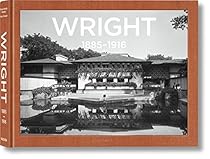Read Frank Lloyd Wright: Complete Works, Vol. 1, 1885-1916 by Bruce Brooks Pfeiffer Online
# Frank Lloyd Wright: Complete Works, Vol. 1, 1885-1916 ¿ PDF Download by # Bruce Brooks Pfeiffer eBook or Kindle ePUB Online free. Frank Lloyd Wright: Complete Works, Vol. 1, 1885-1916 The Wright stuff: The definitive publication on America’s greatest architectFrank Lloyd Wright (1867-1959) is widely considered to be the greatest American architect of all time; indeed, his work virtually ushered in the modern era and remains highly influential today. Wright’s architectural work during these early years was mostly residential, as it would be throughout his career, and from his earliest work, Frank Lloyd Wright demonstrated a knowled

| Title | : | Frank Lloyd Wright: Complete Works, Vol. 1, 1885-1916 |
| Author | : | |
| Rating | : | 4.92 (899 Votes) |
| Asin | : | 383650927X |
| Format Type | : | paperback |
| Number of Pages | : | 580 Pages |
| Publish Date | : | 2016-06-02 |
| Language | : | English, French, German |
. Peter Gössel runs an agency for museum and exhibition design. For TASCHEN he published monographs on Julius Shulman, R.M. He remains at Taliesin to this day, as director of the Frank Lloyd Wright Archives, a vice-president of the Frank Lloyd Wright Foundation, and author of numerous publications on Wright’
"Beautiful Book, Difficult to Handle and Store" according to Rhode Island Reader. First, it must be said that contents of this book leave almost nothing to be desired. There are excellent photographs and Wright's drawings are reproduced on a rarely seen scale - there are drawings for most verified projects. Printing and presentation is beautiful. The only criticism I have is the inclusion of some projects done in Louis Sullivan's office that cannot be attributed to Wright with certainty. These projects - including Sullivan's now-vanished summer house in Ocean Springs, MS and the house designed for Louis Sullivan's brother Albert in Chicago - are considered Sullivan's work by some historians. The. Quantity over quality The last of the three volumes on FLW from Taschen has finally arrived. In general, it is, like volumes 2 and 3 a major addition to the FLW literature. However, Taschen is becoming increasing sloppy with their print and image quality - more quantity less quality. There are obviously many books that do a far better job in providing photographs of FLWs houses and offices - Schulman's being the most prominent. And throughout the present Taschen volumes, the floor plans/blueprints range from nearly readable to unreadable. This is unfortunate as these volumes - designed to be the defining word on FLW - should really have. Pretty darn good, but Ok, I'm a FLLW nut. I have the twelve volume Japanese set along with the paperbacks and inferior hardcovers that came out at the same time as photographic tours of the actual houses. I also have literally a couple hundred other books and publications that have come out over the years and, since I grew up in Chicago I've actually been to many of the buildings in this book and had public and private tours of them. One thing I will say about all of that is that I am always discovering something new. That includes this book and the second in the series as well.First off, while I appreciate the size I question how well
The Wright stuff: The definitive publication on America’s greatest architectFrank Lloyd Wright (1867-1959) is widely considered to be the greatest American architect of all time; indeed, his work virtually ushered in the modern era and remains highly influential today. Wright’s architectural work during these early years was mostly residential, as it would be throughout his career, and from his earliest work, Frank Lloyd Wright demonstrated a knowledge of and respect for natural materials. The 1908 Avery Coonley residence, the administration building for the Larkin Soap Company (1903–1905), and the Unity Temple (1905) are examples of major works from the period.Text in English, French, and German. From his early Prairie Houses (typified by the Robie House) to the Usonian concept home and progressive “living architecture” buildings to late projects like the spiral Guggenheim Museum in New York and the development of his fantastic vision of a better tomorrow via his concept of the “living city,” all of the phases of Wright’s career are painstakingly described and i
He remains at Taliesin to this day, as director of the Frank Lloyd Wright Archives, a vice-president of the Frank Lloyd Wright Foundation, and author of numerous publications on Wright’s life and work. Schindler, John Lautner and Richard Neutra as well as several titles in the Basic Architecture Series.Bruce Brooks Pfeiffer became Frank Lloyd Wright’s apprentice at the Taliesin Fellowship in 1949. In 1957, he attended the Ecole Nationale des Beaux-Arts in Paris, returning in 1958 to continue his apprenticeship with Wright until his death in 1959. About the Author Peter Gössel runs an agency for museum and exhibition design. For TASCHEN he published monographs on Julius Shulman, R.M.
Download Frank Lloyd Wright: Complete Works, Vol. 1, 1885-1916
Download as PDF : Click Here
Download as DOC : Click Here
Download as RTF : Click Here
